In the digital marketing realm, Pay-Per-Click (PPC) advertising has emerged as a powerful tool to drive targeted traffic and achieve measurable results. However, merely running PPC campaigns isn’t enough; success lies in creating and managing effective campaigns that maximize Return on Investment (ROI). This blog will delve into strategies and tips for crafting PPC campaigns that yield high ROI.
Understanding the Basics of PPC Advertising
PPC advertising operates on a model where advertisers pay a fee each time their ad is clicked. Key platforms like Google Ads, Bing Ads, and social media platforms offer PPC advertising services, allowing businesses to reach their target audience based on keywords, demographics, interests, and more.
How PPC Works:
- Payment per Click: Advertisers only incur costs when a user engages with their ad by clicking on it. This method ensures that businesses pay for actual interactions rather than just ad impressions.
- Auction-Based System: PPC platforms typically employ an auction-based system where advertisers bid on keywords or placements. When a user initiates a search or matches specific criteria, the platform triggers an auction to determine which ads will be displayed and in what order.
- Targeted Audience Reach: PPC advertising allows precise targeting based on various factors. Advertisers can select specific keywords relevant to their offerings, specify demographics (like age, location, and gender), and even target users based on their interests or browsing behavior.
- Ad Placement and Display: Ads are displayed prominently on search engine results pages (SERPs), websites, or social media platforms, depending on the chosen ad format. They can appear above organic search results, alongside content, or within users’ social feeds.
- Cost Control and Budgeting: Advertisers have control over their budgets and can set daily or campaign-specific spending limits. Additionally, they can adjust bids for keywords or placements to manage costs and optimize performance.
Platforms Offering PPC Advertising:
Google Ads:
Google Ads is a dominant player in the PPC advertising realm, allowing businesses to promote their products or services across different Google-owned platforms:
- Search Network: Ads appear on Google’s search engine results pages (SERPs) when users search for specific keywords related to the advertiser’s offerings.
- Display Network: Businesses can display ads on websites within Google’s Display Network, which includes a vast array of partner sites that showcase Google ads.
- YouTube Ads: Advertisers can create and display video ads on YouTube, targeting specific audiences based on demographics, interests, and viewing behaviors.
Bing Ads:
Similar to Google Ads, Bing Ads is Microsoft’s advertising platform offering PPC advertising on Bing’s search engine and its network of partner sites. Advertisers can create and display ads on Bing’s search results, leveraging audience targeting options similar to Google Ads.
Social Media Platforms:
Numerous social media platforms provide PPC advertising services, allowing businesses to promote their products or services to their target audiences. Some prominent platforms include:
Facebook:
- Comprehensive Advertising Options: Facebook provides a robust advertising platform with various ad formats, including images, videos, carousels, and more. Advertisers can create highly targeted ads tailored to specific campaign objectives.
- Detailed Targeting Options: Advertisers can leverage Facebook’s extensive targeting capabilities, allowing them to reach users based on interests, demographics (age, gender, location), behaviors, connections, and more. Custom audiences and Lookalike audiences further enhance targeting precision.
Instagram:
- Visually Appealing Ads: As a part of Facebook’s advertising ecosystem, Instagram allows advertisers to create visually engaging ads that seamlessly blend into users’ feeds or stories. Ad formats include image ads, video ads, carousel ads, and more.
- Targeting Based on Interests and Demographics: Advertisers can target Instagram users based on their interests, demographics, and behavior patterns similar to Facebook. This targeting aims to ensure that ads are shown to users who are more likely to engage or convert.
Twitter:
- Promotion of Tweets, Profiles, or Trends: Twitter’s advertising platform enables businesses to promote tweets, profiles, or trends to their target audience. Advertisers can use various ad formats to engage users and enhance visibility.
- Targeting Options: Advertisers can target users on Twitter based on interests, demographics (age, gender, location), language, device, keywords, followers, or tailored audiences.
- Professional Networking Focus: LinkedIn caters to professional networking and offers advertising options tailored for businesses targeting a professional audience.
- Targeted Advertising Options: Advertisers can target LinkedIn users based on job titles, industries, company sizes, skills, education, and more. This platform allows for the precise targeting of professionals, making it ideal for B2B marketing or professional service offerings.
Benefits of PPC Advertising:
Immediate Visibility:
PPC ads provide businesses with an immediate online presence. Once a PPC campaign is launched, ads can appear on search engine results pages (SERPs) or relevant websites almost instantly. Unlike organic methods that may take time to rank, PPC ads offer immediate visibility to the target audience, directing them to a specific website, product page, or landing page.
Precise Targeting:
One of the greatest advantages of PPC advertising is the ability to precisely target a specific audience. Advertisers can tailor their campaigns to reach users based on various factors such as demographics (age, gender, income), geographic location, interests, behaviors, device types, and even specific keywords. This granular targeting ensures that ads are shown only to users who are more likely to be interested in the products or services being offered, increasing the chances of engagement and conversion.
Measurable Results:
PPC campaigns provide comprehensive and detailed analytics tools that offer insights into campaign performance. Advertisers can track various metrics such as impressions, clicks, click-through rates (CTRs), conversion rates, cost per click (CPC), cost per acquisition (CPA), and return on investment (ROI). This data allows for precise measurement and analysis of campaign effectiveness, enabling advertisers to make informed, data-driven decisions for optimization and budget allocation.
Benefits Recap:
- Speedy Visibility:
PPC ads offer immediate visibility as they are displayed promptly upon launching a campaign. Whether appearing on search engine results pages (SERPs) or relevant websites, PPC ads quickly reach the intended audience without the need for organic ranking, ensuring immediate exposure to potential customers actively seeking related products or services.
- Focused Targeting:
One of the key advantages of PPC advertising lies in its precise audience targeting capabilities. Advertisers can tailor their campaigns to reach specific demographics, such as age, gender, location, income, or interests. Behavioral targeting allows ads to reach users based on their online activities and previous interactions, ensuring that ads are shown to those most likely to engage or convert.
- Quantifiable Metrics:
PPC campaigns provide detailed analytics and measurable metrics that offer insights into campaign performance. Metrics such as impressions, clicks, click-through rates (CTR), conversion rates, cost per click (CPC), cost per acquisition (CPA), and return on investment (ROI) enable advertisers to gauge the effectiveness of their campaigns and track progress toward their goals.
- Optimization Opportunities:
Analyzing the data derived from PPC campaign metrics offers valuable insights for refining strategies. By identifying top-performing keywords, ad copies, or targeting parameters, advertisers can optimize their campaigns for better results. Continuous optimization helps in enhancing ad relevance, improving CTRs, lowering costs, and ultimately maximizing ROI.
- Cost Control:
PPC advertising allows advertisers to have control over their budgets and spending. Setting daily or campaign-specific budgets helps manage costs effectively. Additionally, bid adjustments and reallocation of budgets to high-performing campaigns or keywords allow for better utilization of resources while maintaining cost control.
- Real-Time Adjustments:
PPC platforms enable real-time adjustments, allowing advertisers to make quick changes based on campaign performance. Whether it’s adjusting bids, modifying ad creatives, or pausing underperforming ads, the ability to react promptly to campaign data ensures ongoing optimization and the potential for improved outcomes.
Steps to Maximize ROI with PPC Campaigns
1. Define Clear Goals and KPIs
Before launching a PPC campaign, it’s crucial to define clear, specific goals and Key Performance Indicators (KPIs). Whether it’s increasing sales, generating leads, boosting website traffic, or enhancing brand awareness, having well-defined objectives will guide the campaign strategy.
2. Thorough Keyword Research
Keyword research is the foundation of any successful PPC campaign. Utilize tools like Google Keyword Planner, SEMrush, or Ahrefs to identify high-performing keywords relevant to your business. Focus on long-tail keywords, and negative keywords, and consider the user’s search intent to optimize targeting.
3. Compelling Ad Copy and Creative
Craft attention-grabbing ad copy that resonates with your audience and aligns with their needs. Ensure clarity, relevance, and a strong Call-to-Action (CTA). Additionally, incorporate visually appealing creatives or videos to enhance engagement and encourage clicks.
4. Strategic Bidding and Budget Allocation
Strategic bidding is crucial to control costs and maximize ROI. Experiment with bidding strategies like Manual CPC, Target CPA, or Enhanced CPC based on campaign objectives. Allocate budget effectively across campaigns, focusing more on well-performing keywords and ad groups.
5. A/B Testing and Optimization
Continuous testing and optimization are essential for improving campaign performance. Conduct A/B tests on ad copies, landing pages, keywords, and targeting parameters to identify what resonates best with the audience. Use data-driven insights to refine PPC campaigns and improve ROI.
6. Landing Page Optimization
Ensure that the landing page linked to your ads provides a seamless and relevant user experience. Optimize landing pages for speed, relevance, and clarity, aligning with the ad’s messaging. A well-optimized landing page can significantly impact conversion rates and ROI.
7. Monitor, Analyze, and Adapt
Regularly monitor PPC campaign performance using analytics tools provided by the advertising platforms. Analyze metrics such as Click-Through Rate (CTR), Conversion Rate, Cost per Conversion, and Quality Score. Use these insights to make informed adjustments and optimizations to the campaign strategy.
8. Remarketing and Retargeting Strategies
Implement remarketing or retargeting tactics to re-engage with users who previously interacted with your website or ads. Customized ads targeting these users can yield higher conversion rates and contribute to overall campaign ROI.
Maximizing ROI with PPC campaigns demands a strategic approach, continuous optimization, and a deep understanding of your target audience. By setting clear goals, conducting thorough research, crafting compelling ad content, and consistently analyzing performance, businesses can harness the full potential of PPC advertising to drive meaningful results and achieve a higher return on investment.




